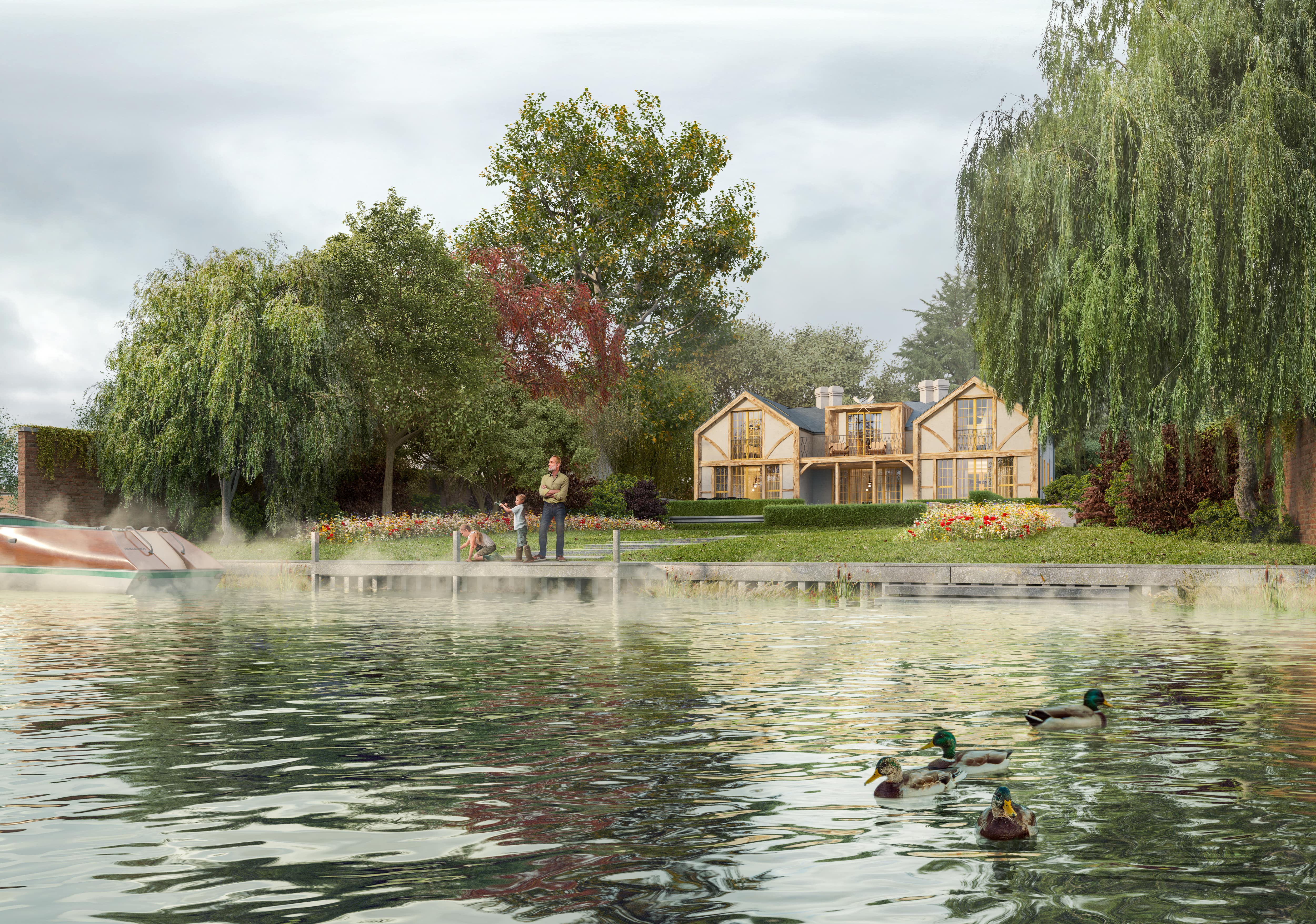
1704974400000
Misty River House
Fusing tradition and modern methods of constructionThe Misty River House is a pre-existing residence situated in Henley upon Thames. The homeowners engaged Baca Architects to replace the current substandard dwelling with a meticulously designed amphibious house. This initiative aims to enhance the visual appeal of the riverfront while concurrently mitigating flood risk for its residents. The house is not located within a conservation area but is located within the local Greenbelt. The replacement dwelling will be amphibious. An Amphibious House is a building that sits on the ground, within a ‘dock’, and is designed to rise from its ‘dock’ on the rare occasion when an extreme flood occurs. This form of construction will help reduce the risk of the existing property and to the surrounding properties by providing additional flood storage under the building. This type of property has the benefit of improving the relationship of the building to the ground plain by providing fewer steps up to the building and eliminating the redundant void below the existing ground floor; that would occur if the replacement dwelling were to be stilted. It also provides an adaptable response to climate changes as the building will always float above the highest flood levels. Baca Architects built the UK’s first amphibious house in Marlow, Buckinghamshire almost a decade ago and the building is acknowledged nationally and internationally as an exemplar of flood mitigation design, especially in riverside locations. Hydroscapes: A meticulously planned garden by Richard Miers Garden Design (named ‘People’s Choice’ award winner at the Chelsea Flower Show 2022) serves as a natural flood alert mechanism. Terraces arranged at varying heights are strategically constructed to flood gradually, notifying residents well in advance of any imminent threat from rising floodwaters. At Baca Architects, we refer to this concept as ‘an intuitive landscape’. The bottom terrace features a lawn and wild flower meadow, the next one includes shrubs and plants, while the seating deck is situated one level above. The highest terrace, positioned just below the living room, acts as the peak point. This tiered arrangement aids in swift recovery by offering dry zones as water levels recede, and the plants play a role in minimizing the erosion of the embankment. The landscape will deliver a 10% ecological gain on the site. CONSTRUCTION: The replacement dwelling would be constructed from high quality materials. The building deploys an oak timber frame building combined with lime-rendered structurally insulated panels. This combines the best of low energy design and traditional craftsmanship with modern methods of construction. The building will be low energy construction and seeks to achieve low carbon construction in its build. The proposal has adopted energy hierarchy - to be lean, clean, and green; and archiving a significant reduction in Carbon emissions over current Part L Building regulations. The whole life carbon assessment demonstrated that the embodied carbon of the project will be less than refurbishing the existing building after every flood event throughout the building 75-year lifespan. CONCLUSION: The replacement dwelling will improve the riverfront frontage and create an attractive addition to the housing stock along this stretch of the river in Henley upon Thames. Considering that this is a replacement dwelling in flood zone 3, the proposed building will deliver a low carbon solution, high quality, beautiful, architectural design sympathetic to its setting and will protect the residents from flooding deep into the 21st Century.

1689681600000
Flood-Re
According to Flood Re, a partnership between the insurance industry and the UK Government, there are 2 million people across the UK exposed to 'frequent flooding.' They have a greater than 10% chance of being flooded in the next decade. Climate change and increased flooding are sadly two sides of the same coin. When our practice first started research in the flood sector, the average cost of repairing a flooded home was £22k. This has now risen to £32k. Some good news: 266,000 Flood Re policies were taken up in 2022. If flooded, Flood Re will provide up to £10K in addition to the repair costs to 'Build-back-better,' making homes more secure and more flood-resilient to what will inevitably come. Baca Director Richard Coutts was invited to the Launch of Flood Re's Transition Plan 2023 at the top of the Gherkin last week. Not only for the event but also as an architect, level 40 (building by Fosters & Partners) provides some of the best views of the City of London. It also affords a wonderful view of Lloyds of London by Richard Rogers.Laura Tobin, Meteorologist, and Weather Presenter provided a great introduction to the event and some sobering statistics on climate change. She rallied the audience to keep the global temperature within 1.5 degrees Celsius. At 1.5°C, summer maximum rainfall could increase by 4%. At 3°C, summer maximum rainfall could increase by 7%. Interspersed with dryer spells, the consequences of surface water runoff will be significant. For those considering buying a house soon, please enter your postcode into the EA’s searches. It will give you an instant indication of the risk from both river and surface water flooding. Avoidance is key. If you can't avoid it, then utilize the government’s flood insurance.Link: https://www.floodre.co.uk

1678968000000
MIPIM World
Our CEO, Richard Coutts, is participating in MIPIMWorld, the largest annual global property event. He will be part of a panel discussing the crucial issue of water in the context of property development. Panelists: Jean-Christophe TaretAlexandra NotayRichard CouttsHarold Spies Currently, 30 cities in France are facing water shortages even before winter ends, and special measures for water usage will be announced soon. Water sobriety is now the new buzzword in Europe as the continent copes with the effects of extreme weather conditions. Stay tuned for more updates as there are insightful solutions in South Africa. #sustainability #baca #propertydevelopment #water #southafrica #france #mipim2023 #watermanagement #waterconservation

1673611200000
Weave House
New Flood Resilient Homes.After the long lag caused by the covid pandemic, we are pleased to report a wave on new flood resilient homes will start in site this year that will test new technologies and with innovation at the threshold of current policy parameters. Weave House has secured full planning permission in Chelmsford. A suburban infill site next to a river the site has provided both a challenge in terms of tackling traditional infill policy with the complexity of flooding. The 285m² (3000sq ft) 'part flood-resilient, part-elevated' Weave House will replace an existing, rundown house and outbuildings. The project, which is expected to cost around £900,000, features two blocks connected by a ramped spine. The landscaping will re-wild several areas of the garden by removing much of the existing hard standing. Featured on AJ : https://www.architectsjournal.co.uk/news/baca-wins-approval-for-flood-resilient-house-in-chelmsford

1670414400000
Protecting Future Homeowners from Flooding
Last week, Baca Director Richard Coutts visited the 'Flood school' at HR Wallingford’s flood testing site near Oxfordshire to attend Flood Re’s 'Property Resilience Roundtable.' Flood Re is a reinsurance scheme that makes flood cover more widely available and affordable to homeowners. The topics covered included an update on the PFR Community of Interest, the Flood Compliance Platform, a detailed update on and practical exercise on Build Back Better, an update on the Scoring Project, and updates from Defra and the Environment Agency on policy and implementation. Moving forward It is our observation that homeowners will not wade through 500-page manuals and, often and reluctantly, will only engage with the statutory requirements of the building regulations. Recent conversations with clients have included challenging discussions over their requirement to have larger areas of glazing and questioning why we need to deliver 10% net biological gain. Another observation is the growing trend to pave over front gardens to enable electric cars to charge next to the home – the owners feel they’ve done their bit for the environment when, conversely, they are removing landscaping that attenuates and reduces surface water flooding. The rising cost of fuel prices has also added to the mix, and hence it is in this context that the Flood Re Insurance Coverage and proposed version of the EPC Certificate should be considered. The data sets are encouraging, but what is clear is how best now to translate complex data (and, as we know, every flood site is different) into some simple, comprehensive guidance that empowers householders to improve their stock either proactively or after a flood event has occurred to boost their future resilience. Our suggestions: - Based on your postcode, the EA has flood mapping that provides information on the severity and probability of a flood event. Perhaps this information can also provide the height of the floodwaters (This information is available from the EA in Flood Pack 4).- Based on the above, the homeowner is directed to no more than 10-20 products and solutions – each with a weighting that is linked to the EPC score. The guidance - linked to updated building regs - will provide sample detailing and retrofitting information on how best to fit individual products and/or as a suite of solutions.- Flood Re to provide guidance on the financial benefits to the homeowner for doing so (i.e., payback periods balanced against the probability of flooding). The assessment should also include what percentage of the property's external spaces are hard or soft (therefore addressing issues such as paving over gardens for electric cars and considering permeable paving as an alternative) and therefore not exacerbating surface water flooding.

1654603200000
Sulby Riverside
We are pleased to report that the Sulby Riverside Planning application on the Isle of Man has been submitted. The £40m scheme will provide a ‘major boost’ to Ramsey town centre and will include 205 new homes, retail units, business workspace, three public parks, and a riverside gastro-pub with function rooms. In 2019, at the ICAADE (Internal Conference on Amphibious Architecture, Design, and Engineering) in Warsaw, Richard Coutts, Director of Baca Architects, presented “Blue Drempel – a thesis on urban flood-resilient design,” which built on the earlier philosophies developed with funding from Defra for Baca’s LifE Project. The masterplan at Sulby Riverside demonstrates proof of concept of this approach and was developed in partnership with hydrologists and flood modellers JBA and HR Wallingfords. “Blue Drempel” or Blue Thresholds is a non-defensive planning strategy that locates architectural housing types according to flood risk: floating within the river; amphibious; elevated; resilient (dry proof and wet proof) to traditional to correspond with diminishing flood risk. It connects these with the least amount of road and servicing infrastructure to allow as much space for natural landscaping. This landscaping is multi-functional, accommodating places for play and sustainable urban drainage designed to anticipate flooding. It keeps water away from housing for as long as possible during a flood event. In the event of the landscaping being breached during an extreme flood event, the resilient and adaptable measures of each architectural housing type help keep occupants dry and safe. Detailed modelling was carried out to demonstrate that the scheme poses no risks to the river’s flow, either upstream or downstream. “At its heart, Sulby Riverside is about place-making,” says Richard Coutts. “These proposals are about opening a site that has been unavailable to the public for many years and organizing a new residential community around open spaces, public footpaths and trails, and the riverside walk. It’s a progressive approach to flood mitigation that can unlock strategic sites.” Key features of the proposals include: - A new riverside walk- Three new parks and play areas- A new spine road linking Poyll Dooey Road with Gardener’s Lane- Ample car parking, with extensive provision of electric charging points- Low-energy design features throughout all homes- Significant job-creating investment, including a new riverside gastro pub- A new parade of shops- A cluster of kiosks next to a new riverside nature trail, for seasonal use As published on the BBC: https://www.bbc.co.uk/news/world-europe-isle-of-man-61711140 #architecture #planning #climatechange #resilience #urbandesign #flood #amphibious

1651586156000
Per Mare per Terram. By Sea, by Land
Many few will know that through our association with water, and particularly our amphibious approach, we have become the friends of the Royal Marine Commandos. To date we have designed and constructed memorials to honour past and current events including memorials at the National Arboretum, Bordeaux (Cockleshell heroes), Iraq, Afghanistan, and others. This year is the 40th anniversary of the Falklands War.Located on a defunct helicopter pad at Port Stanley, we worked with Leander Architectural at a forge in Derbyshire to craft a three-dimensional emblem that adorns a rock from the nearby hills of goose green. Some more personal plaques are bound to the hillside where heroes made the ultimate sacrifice.Veterans of the campaign and their families, bereaved family members, and civilians who supported the Armed Forces will attended a commemorative event at the National Memorial Arboretum, Lichfield, Staffordshire on Tuesday 14 June.

1651147200000
Flood-Re
Baca Director, Richard Coutts attended the launch of Flood-re’s ‘Build back better initiative’ at the House of Commons. Build Back Better is an innovative new way of thinking about home flood insurance. The initiative means families are out of their homes for a fraction of the time and insurers can have the confidence that the properties they cover are more resilient to flood events meaning much lower future claims What Flood Re isFlood Re is a re-insurance scheme that began operation in 2016. It allows insurance companies to pool the potential costs of the higher risk to many properties by paying a special levy. Because Flood Re is a re-insurance scheme, it works with insurers rather than customers.The eligibility rules for Flood Re are however sometimes complex. The scheme excludes commercial properties as well as certain leasehold properties. It also generally excludes buildings constructed since 2009. This is to help dissuade developers from building on land at risk of flooding. Flood Re is due to end in 2039. By that time it aims to have paved the way to a free-market approach in which policy prices reflect risk. How it came aboutThere had been earlier agreements between the Government and the insurance industry to help manage the market. But more severe floods (such as in 2007) had led to large payouts and subsequent increases in prices. This situation threatened a failure of the market in many areas. Parliament set out general arrangements for Flood Re through the Water Act 2014. Performance so far and issues for the futureSince its launch, Flood Re has been able to report strong and clear benefits for most domestic customers in areas at risk. By 2019, for instance, four out of five households with a history of flood claims had seen prices drop by 50%. Flood Re has effectively stabilised the domestic flood insurance market. It now faces the challenge of helping to promote more sustainable approaches to flood prevention, resistance and resilience. These will ultimately be needed if the market is to be able to reflect risk. There is a paradox in this. If customers can buy cheaper flood insurance, they may be less concerned about taking wider action to manage flood risks. In addition, Flood Re doesn’t cover commercial or all residential properties. The Government has tended to highlight industry-led solutions to those problems. After prolonged and repeated flooding events over the winter of 2019-20, the Government announced the launch of the Blanc review, which considered the level and adequacy of flood insurance in affected areas. The report from the review, published in November 2020, found “worrying” levels of coverage in Doncaster, particularly among tenants. It has called for better information and support for both owner-occupiers and tenants, as well as better monitoring of progress. Defra launched a consultation on amendments to the scheme in February 2021. This reiterates the importance of supporting resilience and proposes no changes for general eligibility.

BACA NEWS
Recent Articles
Article Categories




SITE COMING SOON

